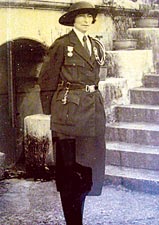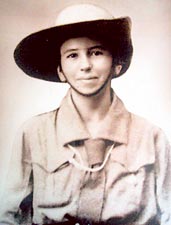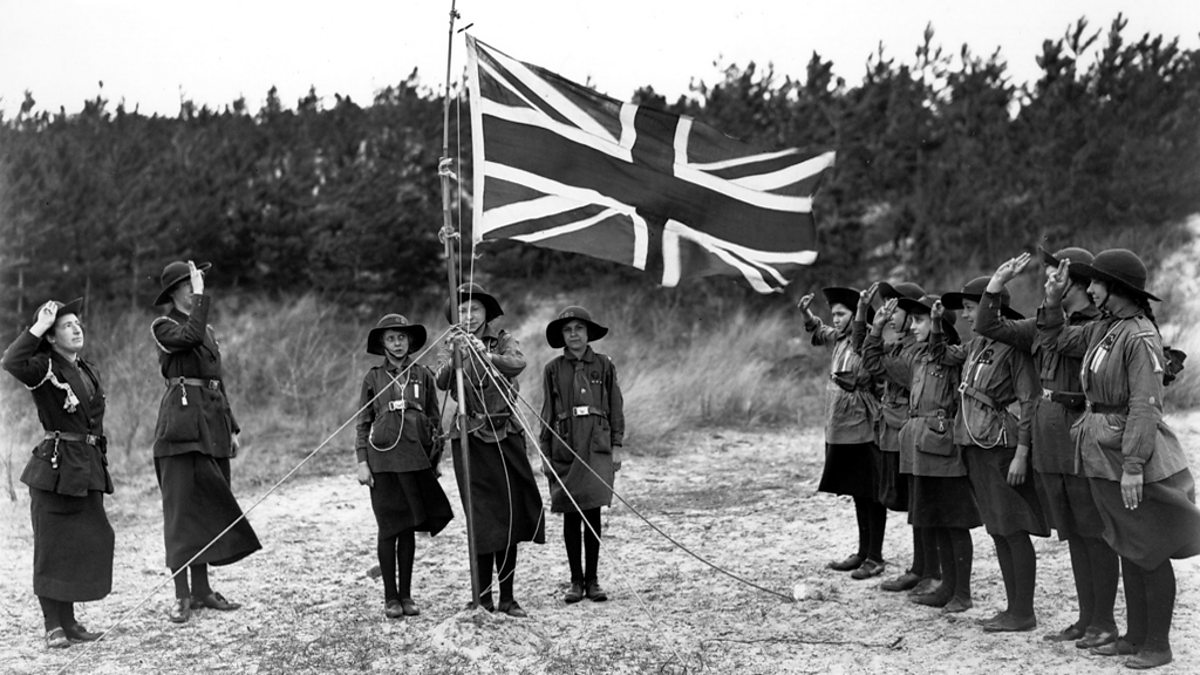Girl Guiding in Ceylon
The Girl Guide and Boy Scout Movements were founded by Lord Robert Baden-Powell (B-P). B-P had first worked with boys while he was in South Africa during the Boer War. He had set up his headquarters in Mafeking, but soon this garrison was under siege. B-P enlisted the help of a few boys to take and carry important messages around town. They were organized into groups or patrols and each patrol had a leader.
The scheme was so successful that on his return home to England B-P decided that boys in England should be taught similar skills such as camping, team work and leadership, pioneering, stalking and orienteering to prepare them for when they were older. He then wrote "Scouting for Boys" describing how this was to be done. Boys all over England read B-P's book and started forming their own Scout companies and carrying out activities in patrols.
The scheme was so successful that on his return home to England B-P decided that boys in England should be taught similar skills such as camping, team work and leadership, pioneering, stalking and orienteering to prepare them for when they were older. He then wrote "Scouting for Boys" describing how this was to be done. Boys all over England read B-P's book and started forming their own Scout companies and carrying out activities in patrols.
 |
| Agnes Baden-Powell |
 |
| Miss. J. Calverley |
In 1909, the first Scout Rally was held at Crystal Palace in London. What B-P was not prepared for was the sight of a band of girls, dressed in variations of the Scout uniform, taking part in the rally.
Having met with and spoken to some of the girls at the rally, B-P realized that he had to provide a similar game for girls. He had to think of a name, and soon he remembered that he had been particularly impressed with some 'Guides' in India.
These men had operated on the North West Frontier and their main task was to go on very dangerous expeditions. Even when they were off duty the 'Guides' were still training their minds and bodies. With this in mind, B-P decided that 'Girl Guides' would be a good name for these pioneering young women.
"A Scheme for Girl Guides" was published in November and on 10th April, 1910 the Girl Guides Association was formed in the UK, with B-P's sister Agnes as the first President of the Girl Guides Association in the UK.
 |
| Rally at Crystal Palace |
 |
| 1909 - Girl Guide at Crystal Palace Rally - RARE |
The first countries in which the Movement was nationally organized were Canada, South Africa, Denmark, Suomi-Finland, the Netherlands, Poland, and the United States of America (USA). When Mrs. Juliette Gordon-Low took over Guiding to the USA in 1912, she found that the name 'Girl Guides' was already in use, and so the Movement in the USA was known as the Girl Scouts of the United States of America.
While on board the SS Arcadian bound for Jamaica in 1912, B-P met and got engaged to Olave St. Clair Soames. They were married later that year and Lady B-P became involved in her husband's work with the Girl Guide and Boy Scout Movements.
While on board the SS Arcadian bound for Jamaica in 1912, B-P met and got engaged to Olave St. Clair Soames. They were married later that year and Lady B-P became involved in her husband's work with the Girl Guide and Boy Scout Movements.
 |
| Lady Baden Powell meets Marlyn Dissanayake at a Scout and Girl Guide Rally in 1958 |
Guiding was introduced to Sri Lanka in 1917 by Mrs. Jenny Greene, then Miss. Jenny Calverley, and the first Guide Company was started at Girls' High School, Kandy with the support of its Principal Miss. Sansom.
Towards the end of the year a meeting to discuss the future of Girl Guiding in Sri Lanka was held in Colombo. At this meeting a decision was taken to alter the wording of the Promise to enable non-Christians to subscribe to it. The spirit of Guiding caught on, and in the same year, the first Guide Company was formed in Colombo at Methodist College. A junior branch called "Rosebuds" (now known as Little Friends) was also formed.
In 1918, the Ceylon Branch of the Girl Guides Association was formed and Mrs. R. W. Byrde was appointed as Sri Lanka's first Chief Commissioner.

 |
 |
In Sri Lanka, the Movement has been empowering girls and young women for over 95 years. Our membership, which numbers over 30,000 in Sri Lanka, spans all 9 provinces. The Sri Lanka Girl Guides Association (SLGGA) is a non-governmental, non-religious organisation which is open to girls and women from all walks of life irrespective of caste, religion, and race.
The SLGGA follows a value-based, non-formal educational programme focusing on community development, environmental awareness, primary health care, drug abuse prevention, the girl child, adolescent health, HIV/AIDS and the integration of the differently abled into normal society. The Association also stresses on leadership training to encourage girls and young women to make their own choices in decision making at all levels.
CHIEF COMMISSIONERS
1918 Mrs R.W.Byrde
1926 Mrs W.T.Southern
Mrs D.Trefusis
1932 Mrs G.S.Wodeman
1934 Lady Stubbs
1938 Mrs Sybil F Morley
1941 Mrs Dorothy Villiers
1942 Mrs Mary Hobson
1950 Ms M Sandys
1952 Ms Edna Alvis ( First Sri Lankan Chief Commissioner)
1958 Mrs Sita Rajasuriya
1968 Mrs Mukta Wijesinha
1973 Mrs Freny Jilla
1978 Mrs Chaturanee Abeywira
1983 Mrs Venetia Gamage
1990 Mrs Julie Samuel
1995 Mrs Ramya Abeykoon
2000 Mrs Marlyn Dissanayaka
2004 Mrs Thilini Atukorala
2007 Ms Kanthi Fernando
2010 Mrs Shanta Jayalath
2013 Miss. Yasmin Raheem201
History
- 1917 First Girl Guide Company was opened in Kandy at the Girls High School by Mrs Jennie Calverley (nee Green).
- The Junior Branch, known as ‘Rosebuds’ was started in Kandy .
- 1919 The first Annual General Meeting was held.
- 1921 Ranger Companies were opened in Kandy and Colombo .
- Visit of Lord and Lady Baden-Powell to Sri Lanka.
- 1922 The Cadet Branch was inaugurated. The first All Island Rally held.
- 1924 The Elephant was adopted as the symbol of the Association.

- 1925 Extension Guiding started at the School for the Deaf and Blind, Ratmalana.
- 1927 Girl Guiding was extended to rural areas of Sri Lanka (then known as Ceylon).
- 1928 The first Girl Guide Headquarters was opened at 18 Baillie Street, Fort, Colombo, as a memorial to Mrs Southern, a former Chief Commissioner.
- 1933 The Constitution of the Association was approved.
- 1934 Headquarters at 10, Edinburgh Crescent (now known as Sir Marcus Fernando Mawatha) was opened.
- Visit of Lord and Lady Baden-Powell to Sri Lanka.
- 1945 The Trefoil Guild was formed
- 1951 The Association was recognized as a Full Member of WAGGGS
- 1952 Ms Edna Alvis was appointed as the first Sri Lankan Chief Commissioner
- Ms Janet Vairakiam appointed as the first International Commissioner
- 1957 Mrs Sita Rajasuriya appointed as the first Advisor for the Branch for the Handicapped .
- Visit of the Chief Guide, Lady Baden-Powell
- 1960 Mrs Sita Rajasuriya elected to the World Committee by the 17th World Conference in Greece
- 1961 New imagery for the Junior Branch (‘Brownies’ now known as ‘Little Friends’) was introduced.
- 1969 Asia Pacific Region set up .
- Mrs Sita Rajasuriya appointed as the first Chairman, Asia Pacific Committee.
- 1970 Ms Siromi Rodrigo appointed as first Asia Pacific Executive .
- 1973 11th Colombo Rangers win Walter Donald Ross Trophy for Service to the Community .
- 1975 Mrs Sita Rajasuriya, Chaired the 22nd World Conference in United Kingdom. She was the first Asian to Chair a World Conference.
- Mrs Mukta Wijesinha elected to the World Committee by the 22nd World Conference
- Mrs Freny Jilla appointed to the Sangam Committee.
- 1976 36th Kandy Ranger Company placed 2nd for the Walter Donald Ross Trophy for service to the community .
- 1977 Diamond Jubilee International Camp in Colombo.
- 1978 Foundation Stone laid for Headquarters extension.
- 1980 ‘Quo Vadis’ International Training Conference held.
- 1981 The name of the Ranger Branch changed to Senior Guide Branch.
- Mrs Freny Jilla elected to the Asia Pacific Committee.
- 1984 “Voice of Youth’, Youth Seminar held with 46 NGOs participating.
- 1985 Death of Mrs Jennie Calverly, Founder of Girl Guiding in Sri Lanka.
- 3rd Colombo Senior Guide Company wins Olave Award.
- 1987 The Vocational Training Centre, Heenatipone, Mawanella opened. Sister Ranwela, donated the land and the Guides and Scouts of Sweden contributed towards the building of the centre.
- Mrs Venetia Gamage, elected to the World Committee by the 26th World Conference .
- Mrs Julie Samuel appointed as substitute member to the Sangam Committee.
- Mrs Indra Ambawatte appointed as substitute member to the Olave House Committee.
- 1990 Mrs Thilini Atukorala appointed as substitute member to the Asia Pacific Committee.
- The National Training Centre (NTC) was opened. The building was financed by the Guides and Scouts of Sweden.
- “Baladakshika Gama” adjoining the NTC was opened. Funds raised by members of the Association to build 10 houses for the homeless in celebration of the “Shelter for the Homeless Year”.
- 1991 Hosted an Asia Pacific event, “Fun in Training”.
- 1993 Mrs Thilini Atukorala re appointed as substitute member of the Asia Pacific Committee.
- Hosted an International event, “Together in a Special Way”.
- Ms Siromi Rodrigo, the first Sri Lankan to be a member of the Olave Baden Powell Society.
- 1995 “Girl Child” programme, financed by UNICEF, launched island wide.
- An Oral Rehydration Therapy (ORT) programme, financed by UNICEF was launched.
- 1996 The first, All Island Peace Camp held in Embilipitya for Guides and non Guides. This was financed by UNICEF.
- Belgium/Sri Lanka exchange programme, group worked at the NTC and the VTC .
- Ms Chamila Pathirana appointed a member of the Finance Committee
- 1997 80th Anniversary celebrations, launched on Thinking Day with Peace Walks islandwide.
- All Island Friendship Camp at Hikkaduwa for Guides and non Guides, sponsored by UNICEF.
- Girl Guiding started in the Prisons.
- 1998 “Building World Citizenship”, launched.
- “Girl Child Programme” launched by the Projects Committee.
- 1999 An International Senior Guide Service Camp, “Building a Better World” held at Vocational Training Centre, Mawanella.
- Received an Asia Pacific Award for an increase in Membership over the triennium.
- 2000 Asia Pacific Committee Meeting held in Sri Lanka .
- Presentation Ceremony, OBPS, held for Mrs Sita Rajasuriya.
- 2001 Ms Kundhavi Balachandran elected to the Asia Pacific Committee by the 7th Asia Pacific Conference .
- 2001 Mrs Kunthavi Balachandran Fernandopulle, elected to the Asia Pacific Committee by the 7th Asia Pacific Committee.
- 2002 Three Asia Pacific Awards presented at Regional Gathering held during the 31st World Conference for Increase in Membership, Participating in “Lend a Hand’ project and Hosting an AP Event.
- 85 years of Girl Guiding in Sri Lanka celebrated with a pageant highlighting the history of Guiding in Sri Lanka.
- 2004 The SLGGA premises and NTC premises vested in the name of the Association.
- Invited to participate in the Jamboree on the Air (JOTA) and a station installed at the SLGGA Headquarters
- Dimanthi Gunawardhana appointed as Programme Assistant (July to September) Sangam
- 2005 New Structure of Association launched
- NTC grounds opened for camping and pack holidays
- Tsunami Task Force (later changed to Disaster Management Committee) set up with Mrs Shanta Jayalath as Chairman.
2006
- 2006 Dimanthi Gunawardhana, first member of SLGGA to be awarded Asia Pacific Young Leaders Scholarship, to attend an event at one of the World Centres.
- HIV/AIDS & Adolescent Health Programme launched.
- VTC closed and premises sold
- ‘Weaving Centre’ located in the NTC premises handed over to SLGGA
2007
- 2007 A booklet “Sundara Jeevithayak” on HIV/AIDS written by 4 Senior Guides, Trinuki Fernando, Thanushi Dissanayake, Punsisi Alahakoon & Prathiba Guneratne, published by the Family Planning Association.
- First activity to celebrate ninety years of Guiding in Sri Lanka held in Colombo with a Walk and a “Skills Exchange Programme” at the Headquarters.
- Training Scheme of SLGGA updated.
- Amila Jayamaha invited by WAGGGS to serve on Working Group, to review WAGGGS Leadership Development Modules .
- Ruchira Jayasingha, served on Planning Committee of Asia Pacific Strategic Leadership Workshop in Cambodia.
- Kunthavi Balachandran appointed Deputy Chairman of 9th Asia Pacific Conference, held in Malaysia.
- Members of SLGGA organized the Youth Pavilion at the 8th International Conference on AIDS in Asia and the Pacific (ICAAP).
- Regular news on Guiding introduced in Sunday ‘Fun Times’ and ‘Wijeya’ newspapers.
- Differently Abled Guides attended for the first time an International Camp in Korea
2008
- 2008 First Adventure Sports Festival organized by Guide Branch with help from Sri Lanka Army Commando Regiment.
- 11th Kandy Guides win Olave Award.
- Wajira Silva and Uthpala Jayasekera appointed as SLGGA’s Centenary Ambassadors .
- 2009 Ms Priyanthi Rajapaksa appointed to the Asia Pacific Resource Pool.
2010
- 2010 Centenary Celebrations launched at Girl Guide Headquarters.
- ‘Centenary Friendship Circle’, an International Camp held at Nainamadama.
- A Guide Company opened in an IDP Camp in Ratmalana.
- ‘A Journey of a 100 Friends” a Centenary celebration. Trip by train and bus from South to North of the country.
- Ruchira Jayasingha, Deputy Chairman, 10th Asia Pacific Conference.
2011
- 2011 Opening of Mukta Wijesinha Hall at the NTC .
- Asia Pacific Regional Committee Meeting hosted by SLGGA.
- All Island Rally 2011, held on the Galle Face Green.
- International Camp for the Differently Abled held in Colombo.
- SLGGA participation in a ‘Heart Run’ on ‘World Health Day.




